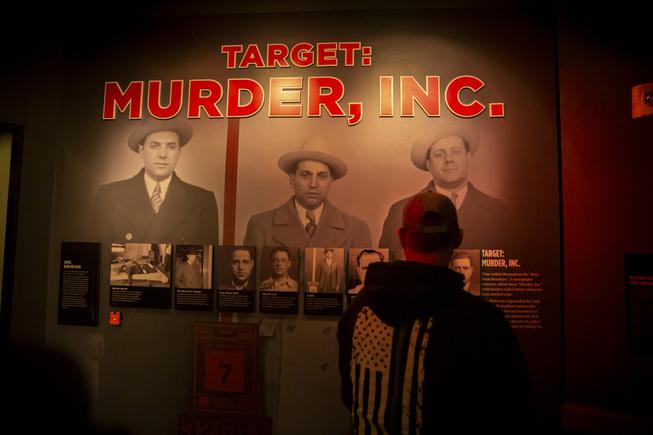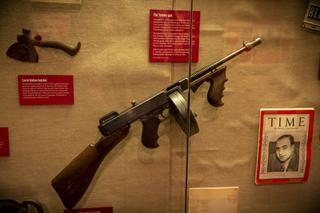Monday, Feb. 14, 2022 | 2 a.m.
As she walked through the Mob Museum, Melissa Rice marveled at the overwhelming number of artifacts and the rich history on display.
From Al Capone, former leader of the infamous Chicago Outfit, to Bugsy Siegel, Meyer Lanksy and Fred Burke, America’s most famous gangsters are front and center at the downtown Las Vegas museum.
“This is an impressive place,” said Rice, a visitor from Chicago. “There are these huge floors, and there are a lot of Chicago connections here. A person could spend all day here.”
The National Museum of Organized Crime and Law Enforcement is celebrating its first decade in existence this month. As part of the observance, Nevada residents today get free admission to the museum at the old federal courthouse and post office building, 300 Stewart Ave.
Rice, who was visiting last month with a friend, is one of over 3 million people who have toured the museum since it opened on Valentine’s Day in 2012.
Jonathan Ullman, president and CEO of the museum, said he’s proud of how the museum has grown.
“There’s always so much more we want to do, which I think is part of why we’re successful. We never want to rest on our laurels,” he said. “You always want a museum to be educational and entertaining, but that’s especially important here in Las Vegas.”
From a detailed history of how organized crime in the U.S. took root within impoverished immigrant communities in the late 19th century and early 20th century to numerous interactive exhibits, the museum can keep patrons busy for hours.
Visitors can sit in a replica electric chair and listen to actual law enforcement wiretapped audio recordings. There is a crime lab, a firearms training simulator and distillery tours in the basement speakeasy, the Underground, which was added in 2018.
One of the prized displays is a section of brick wall from the 1929 St. Valentine’s Day Massacre in Chicago. Seven members of gangster Bugs Moran’s gang were lined up against the wall and executed by men allegedly tied to Capone’s gang.
“You can’t tell the story of Las Vegas and you can’t tell the story of America without telling the story of organized crime,” Ullman said.
The 41,000-square-foot building — it went up in 1933 and is on the National Register of Historic Places — was renovated in 2017. A first-floor exhibit space opened in 2018, giving the museum four floors of material.
“We consider the building to be the greatest artifact we have,” Ullman said. “It’s amazing. You don’t find much neoclassical, Depression-era architecture still standing in Las Vegas.”
The framework for the museum was developed in large part by Dennis and Kathy Barrie, a respected Ohio husband and wife curator team.
Dennis Barrie also worked on development of the International Spy Museum in Washington, D.C., with the help of his wife, and the Rock and Roll Hall of Fame in Cleveland. All told, the couple has worked on about 20 museums.
“It was a lot of work to get the Mob Museum open,” Kathy Barrie said. “It’s a topic that is so American. People find it endlessly fascinating.”
Dennis Barrie said he and his wife haven’t been back much to visit the museum since its opening, but they know that the first 10 years have been a success.
“It has a really good reputation, which is important to us,” he said. “Of all the projects Kathy and I have done, the Mob Museum remains one of our favorites. We really had to start from scratch, and getting items was a problem for a while.”
Though it’s referred to as the Mob Museum, the law enforcement component was just as important, Dennis Barrie said.
“People on both sides, family members and descendants, wanted to be involved,” he said. “They wanted everything to be right, to be truthful and correct. We were able to do that. We met a lot of families, some very interesting people.”
Kathy Barrie developed a working relationship with Frank Culotta, a former member of the Chicago Outfit and the infamous Hole in the Wall Gang of burglars in Las Vegas in the 1970s and 1980s.
An admitted killer, Culotta, who died in 2020, provided information used in Nicholas Pileggi’s 1995 book “Casino: Love and Honor in Las Vegas,” which was later adapted into the Martin Scorsese movie “Casino.”
“It was always a little unsettling when Frank’s name would come up on my phone,” Kathy Barrie said with a laugh. “Knowing his background, there was always a little bit of a worry, like, ‘OK, what is this about?’ But he was great, and so many people helped with the development of the museum.”
The history of Las Vegas as a world-renowned tourist destination cannot be properly told without the inclusion of the mob’s influence here. The city has a complicated relationship with organized crime.
For decades, members of the mob skimmed money from Las Vegas casinos and had a big hand in how the city operated. Today, casinos are run mostly by publicly traded companies and are highly regulated.
Perhaps the most well-known living link to the organized crime days in Las Vegas is former Mayor Oscar Goodman, who was a one-time mob attorney.
It was Goodman, 82, who was credited with having the idea for the museum two decades ago.
“Like a lot of ideas I had as mayor, no one believed that we could have a mob museum in Las Vegas, let alone that it would have huge success,” Goodman said in a statement. “Looking back now, everyone sees that this was a no-brainer.”
A known martini drinker — often photographed for public appearances with an oversized martini glass and Las Vegas showgirls — Goodman said he especially enjoys the museum’s Underground lounge.
“They serve a good martini,” he said.
His wife, Carolyn Goodman, the city’s mayor since 2011, is also a big fan of the museum, which is run as a nonprofit and overseen by a governing board that includes the Goodmans.
“It is a first stop for so many visitors and conventiongoers who come to our city for entertainment, major league sports and business,” she said. “I look forward to seeing what exhibits the next 10 years will bring.”
One of the biggest challenges for the museum is finding room to display everything.
“We’re using every inch of this building,” Ullman said. “We need more space, but that’s a wonderful problem to have. How we accomplish that is the next step.”


